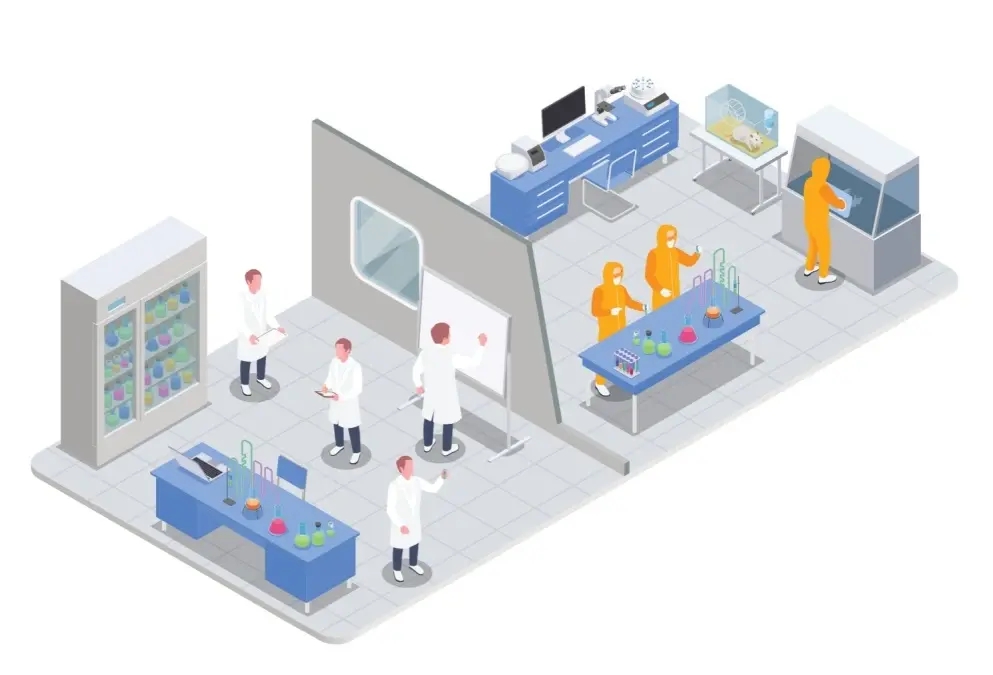Filters in cleanrooms, such as HEPA and ULPA filters, are crucial for removing airborne particles and contaminants. They maintain the controlled environment needed to prevent contamination, ensuring product quality and safety in industries like pharmaceuticals, electronics, and biotechnology, where even microscopic impurities can be detrimental.
Clean Room Design Services
Specializing in cutting-edge cleanroom design, we provide tailored, contamination-free environments that meet strict industry standards. Our designs ensure maximum efficiency and compliance, offering unmatched reliability that competitors can't replicate. Targeted at pharmaceutical industries, we solve the challenge of maintaining sterile conditions, ensuring your products are produced in the purest environments possible.
Advanced Contamination Control
We provide cutting-edge clean room design with superior filtration systems, ensuring pristine environments.
Customized Solutions
Tailored to meet your specific industry needs, offering unmatched precision and compliance.
Targeted Expertise
Ideal for pharmaceutical, biotech, and semiconductor industries.
Problem Solved
We eliminate contamination risks, safeguarding your sensitive operations and product integrity.
What is a Clean Room?
A cleanroom is an enclosed space within a facility, designed to control airflow, pressurization, temperature, and humidity. This environment ensures the critical conditions required for specific processes or product protection from particulates.
Cleanrooms are essential in diverse industries, including pharmaceuticals for drug manufacturing, biotechnology for genetic engineering, semiconductor manufacturing for microchips, aerospace for spacecraft assembly, medical devices for sterile equipment, nanotechnology for nanomaterials, food and beverage for sensitive processing, and optics for precision components.
Clean room HVAC design plays a crucial role in achieving by regulating temperature, humidity, and airflow. These specialized spaces use advanced filtration systems and pressure balance [PR1] to prevent contamination, ensuring a pristine environment for sensitive processes and manufacturing.
Why Cleanrooms are important?
Cleanrooms are essential in various industries for several reasons:
- Preventing contamination in sensitive manufacturing processes
- Ensuring product quality and consistency
- Meeting regulatory requirements and industry standards
- Protecting sensitive equipment from environmental factors
- Safeguarding human health in medical and pharmaceutical applications
- Enabling cutting-edge research and development
How Does a Cleanroom Work?
How Does a Cleanroom Work?
Cleanrooms maintain their pristine environment through a combination of specialized design elements and equipment. High-efficiency air filtration systems remove particles from the air, while carefully controlled airflow patterns prevent contamination. Adequate pressure keeps outside contaminants from entering, and strict protocols for personnel and materials help maintain a clean environment.


Cleanrooms maintain their pristine environment through a combination of specialized design elements and equipment. High-efficiency air filtration systems remove particles from the air, while carefully controlled airflow patterns prevent contamination. Adequate pressure keeps outside contaminants from entering, and strict protocols for personnel and materials help maintain a clean environment.
Industries that Use Cleanrooms
Cleanrooms are vital across various sectors:
- Pharmaceuticals: For drug manufacturing and research
- Biotechnology: In genetic engineering and vaccine development
- Semiconductor Manufacturing: For producing microchips and electronic components
- Aerospace: In satellite and spacecraft assembly
- Medical Device Manufacturing: For producing sterile medical equipment
- Nanotechnology: In developing and working with nanomaterials
- Food and Beverage: For sensitive food processing and packaging
- Optics: In lens and precision optical component manufacturing
These industries rely on cleanrooms to ensure product quality, safety, and compliance with regulations.
Types of Filters and Their Functions
Pre-filters serve as the first line of defense in a cleanroom's filtration system. They capture larger particles, extending the life of more advanced filters downstream. Pre-filters are cost-effective and easily replaceable, making them crucial for maintaining overall system efficiency.
Ultra-low particulate Air (ULPA) filters are designed to remove 99.9995% of particles 0.12 micrometers in size or larger. These high-performance filters are used in the most stringent cleanroom environments, such as those in semiconductor manufacturing or nanotechnology research.
The global ULPA Air Filters market size was USD 647.9 million in 2021 and the market is projected to touch USD 1106.6 million in 2032, at CAGR of 5.0% during the forecast period.
High-efficiency particulate Air (HEPA) filters are the backbone of most cleanroom filtration systems. The function of HEPA filters in a clean room is to remove 99.97% of particles 0.3 micrometers or larger from the air . They play a crucial role in maintaining air quality by capturing a wide range of contaminants, including dust, pollen, bacteria, and some viruses.
The global HEPA filters market size was valued at USD 3,274.31 million in 2023. It is projected to reach USD 4,816.96 million by 2032, growing at a CAGR of 8.1% during the forecast period (2024–2032).
HEPA filters work through a combination of mechanisms:
- Interception: Particles adhere to filter fibers as they pass through
- Impaction: Larger particles collide with fibers and become trapped
- Diffusion: Smaller particles move erratically, increasing their chances of capture
The efficiency of HEPA filters makes them indispensable in pharmaceutical, medical, and high-tech manufacturing cleanrooms.
HVAC System in Clean Rooms
The HVAC system is critical in maintaining the controlled environment of a clean room. It not only regulates temperature and humidity but also ensures proper air distribution and filtration. A well-designed HVAC system helps maintain the required type and level of pressure that prevents contamination and supports the overall cleanliness classification of the room.
Laminar airflow can be integrated with the HVAC system to enhance cleanliness. This type of airflow moves air in a unidirectional pattern, typically from the ceiling to the floor, creating a "curtain" of clean air around work areas. Laminar airflow systems:
- Minimize turbulence, reducing the chance of particle suspension
- Quickly remove contaminants from the air
- Provide a consistent, predictable airflow pattern
- Enhance overall cleanroom performance
By combining an efficient HVAC system with laminar airflow, cleanrooms can achieve and maintain the highest levels of cleanliness required for sensitive operations.
Pharmaceutical Clean Room Classification
Pharmaceutical clean room design is guided by strict classifications based on the maximum allowed particles per cubic meter of air. These classifications, ranging from ISO 1 (most stringent) to ISO 9(normal room air), determine the level of cleanliness required for different pharmaceutical processes. Proper design and maintenance are crucial to meet these standards and ensure product safety and quality.
Why Clean Room Consultants Need MEP Engineers
Creating a clean room is an intricate process that requires meticulous planning and specialized expertise. One often overlooked but crucial aspect is the role of Mechanical, Electrical, and Plumbing (MEP) engineers, particularly in the design of HVAC systems.
Clean rooms demand a high level of environmental control to prevent contamination, and this is where MEP engineers come in. They design sophisticated HVAC systems that ensure precise temperature, humidity, and pressure conditions. Without their expertise, maintaining the stringent standards required for clean rooms—whether for pharmaceuticals, electronics, or healthcare—would be nearly impossible.
HVAC design is critical in clean rooms because it controls airflow patterns, filtration levels, and air changes per hour, which are essential to eliminate contaminants. An ill-designed system can lead to significant operational inefficiencies and even compromise product integrity and safety.
In essence, the collaboration between clean room consultants and MEP engineers is indispensable. The engineers' technical acumen in designing and implementing HVAC systems transforms a vision of a contamination-free environment into a reality. Therefore, for any clean room project, enlisting the skills of an experienced MEP engineer is not just beneficial, it is essential.
Optimize Your Clean Room Design with NY Engineers
Designing a cleanroom, which includes HVAC design, is a complex process that requires expertise and precision. The right design ensures optimal performance, regulatory compliance, and cost-effectiveness. When seeking clean room design firms, NY Engineers stands out as the best choice. Our team combines extensive experience with cutting-edge knowledge to deliver cleanroom solutions that meet and exceed industry standards, making us your ideal partner in creating the perfect controlled environment for your needs.




